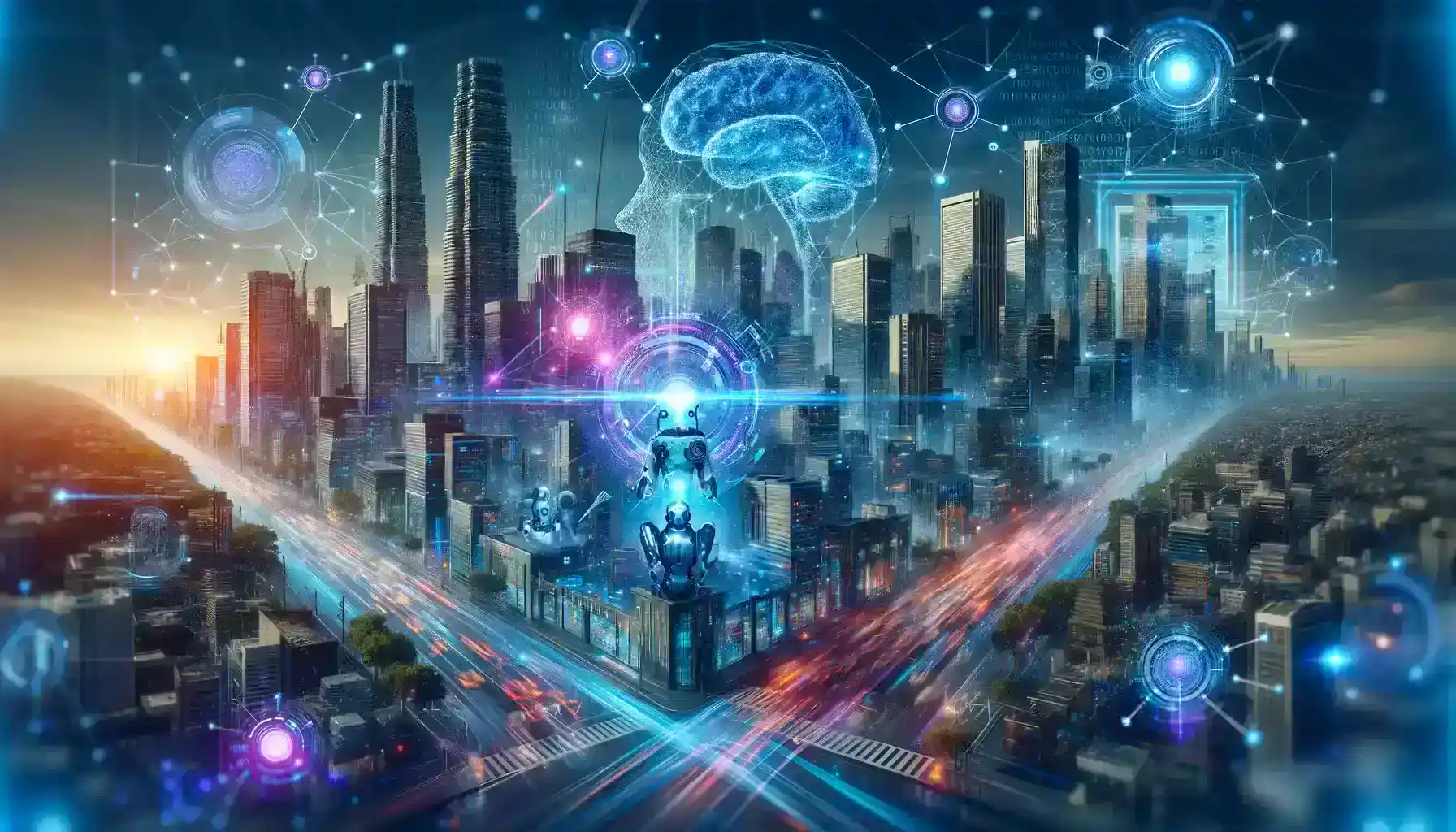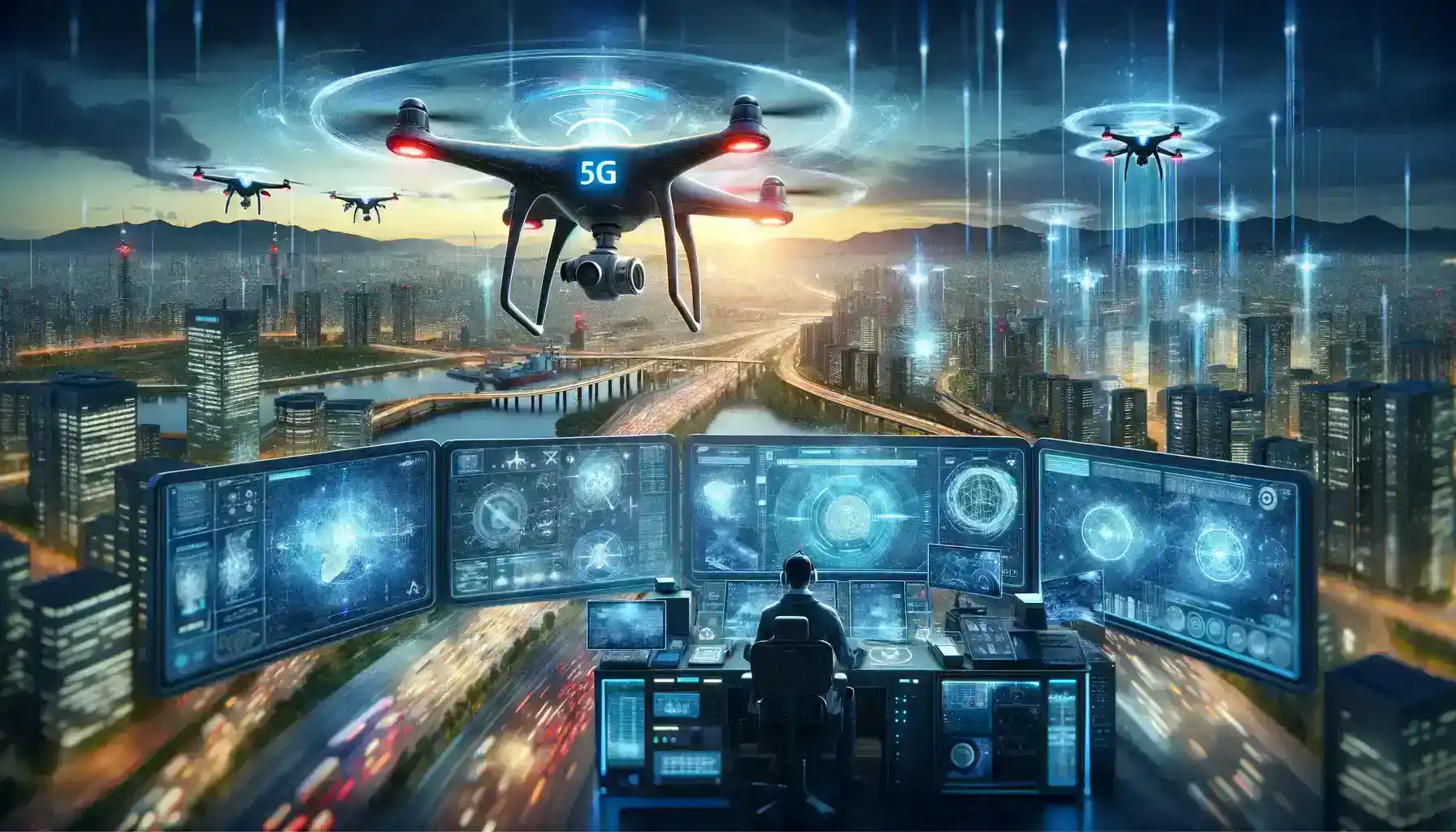Table of Contents
In the vanguard of the Fourth Industrial Revolution, two titans of technological innovation stand at the forefront: Artificial Intelligence (AI) and 5G Technology. These forces are not merely reshaping the infrastructure of connectivity and computation but are also redefining the bounds of possibility across societal, economic, and technological domains. As we stand on the cusp of this new era, “AI and 5G Technology” are the harbingers of unprecedented progress, promising a future that is more interconnected, intelligent, and innovative.
AI, with its capacity to analyze and learn from data, is revolutionizing problem-solving and decision-making processes. From self-learning algorithms to autonomous systems, AI is a cornerstone of modern tech, endowing machines with the ability to act and react in complex environments. Meanwhile, 5G Technology, with its blistering speeds and minimal latency, is becoming the backbone of modern communication, enabling a level of hyper-connectivity that previous generations could barely fathom.

1. The evolution of AI and the advent of 5G
The evolution of AI and the advent of 5G technology represent two of the most significant milestones in the trajectory of modern technological progress. AI has undergone a renaissance in the last decade, evolving from simple rule-based algorithms to complex neural networks capable of deep learning and natural language processing. This transformation has been driven by exponential increases in computational power and the availability of big data, which have allowed AI systems to learn and improve at an unprecedented rate.
In smart manufacturing, 5G’s low latency and high reliability enable AI-powered robots to communicate and collaborate in real time, optimizing production lines and reducing downtime. For instance, BMW’s use of 5G technology in their automated logistics processes allows for seamless communication between AI systems, enhancing efficiency and flexibility in manufacturing operations.
The convergence of AI and 5G technologies is creating synergies that amplify their unique capabilities. AI applications that require instant data processing and decision-making can leverage 5G’s low latency and high bandwidth to operate more effectively and reliably. Conversely, the vast data networks supported by 5G infrastructure provide the fuel for AI to learn and adapt, creating smarter, more responsive systems.
2. AI and 5G Technology as Catalysts for Societal Transformation

AI and 5G technology are being hailed as twin catalysts for societal transformation, each amplifying the capabilities of the other and enabling a host of applications that were previously infeasible. This combination is setting the stage for a smarter, more connected world.
AI, with its ability to process and learn from vast amounts of data, has seen applications in everything from consumer technology to industrial systems. It’s the driving force behind personalized recommendations on streaming services, intelligent routing in logistics, and even the predictive maintenance of critical infrastructure. AI systems can adapt and respond to changing circumstances, optimizing themselves in ways that preprogrammed software cannot.
A striking instance of this synergy is found in the realm of emergency services. For example, in South Korea, 5G technology has been deployed to enhance their emergency response systems. With the help of AI, 5G-enabled drones can be dispatched to assess crisis situations.
These drones stream live footage back to control centers at speeds and resolutions that were not possible with previous generations of mobile technology. AI algorithms then analyze this footage in real-time to provide emergency responders with critical information, such as the safest routes to take or the most critical areas in need of attention.
3. Economic Impacts and Opportunities
The integration of AI and 5G technology is not just a technical evolution; it is a transformative economic force. This powerful duo is giving birth to new industries, reshaping job markets, enhancing efficiency and productivity in existing sectors, and altering global economic patterns and power dynamics.
New Industries and Job Markets
The emergence of AI and 5G technology has catalyzed the creation of industries that once existed only in the realm of science fiction. One such industry is the commercial spaceflight sector. Companies like SpaceX are utilizing AI to optimize flight paths in real time while leveraging 5G for ground-to-spacecraft communication. This industry is not only opening new frontiers in space tourism but also creating jobs in aerospace engineering, AI development, and telecommunications that did not exist a decade ago.
In agriculture, AI and 5G technology are being employed to create precision farming techniques. Drones survey crops using high-resolution cameras, and AI algorithms analyze the data to optimize planting patterns, irrigation, and pest control. The result is higher yields, less waste, and more sustainable farming practices.
Efficiency and Productivity Gains
In the manufacturing sector, AI-driven automation and 5G’s reliable, high-speed communication are synergistically working to create ‘smart factories.’ For example, Siemens uses AI algorithms to predict maintenance needs for industrial machinery, minimizing downtime. When coupled with 5G’s ability to facilitate communication between machines, this predictive maintenance can occur almost instantaneously, significantly improving productivity.
Global Economic Patterns and Power Dynamics
AI and 5G are also reshaping global economic dynamics. They are enabling developing countries to leapfrog traditional stages of industrialization. In Kenya, 5G’s rollout is expected to accelerate the country’s digital economy, while AI is being leveraged to enhance agricultural practices, such as pest prediction and soil health monitoring, thus improving yields. This tech leap can potentially reposition economies on the global stage, shifting power dynamics as digital prowess becomes a new measure of influence.
3. Technological Innovations Fueled by AI and 5G Technology
Technological innovation is the cornerstone of the modern era, driven forward by continuous advancements in Artificial Intelligence (AI) and the rollout of 5G technologies. These two technological leviathans are not merely changing the landscape of digital communication and computation; they are the architects of a new future, where the synergy between high-speed connectivity and intelligent automation spawns unprecedented breakthroughs across various sectors.
Autonomous Vehicles and Transport Systems
The domain of transportation is witnessing a significant transformation with the integration of AI and 5G technology. Autonomous vehicles, once a figment of science fiction, are now becoming a tangible reality, as AI’s advanced machine learning algorithms are combined with the ultra-reliable low-latency communication (URLLC) provided by 5G networks. This combination ensures that vehicles can make real-time decisions, communicate with one another, and respond to dynamic traffic conditions without human intervention.
In transportation, the city of Seoul has deployed a 5G-powered traffic management system that uses AI to analyze traffic data in real-time. This system adjusts traffic signals to improve flow, reduces congestion, and minimizes travel times, making the city more navigable for its citizens and reducing carbon emissions from idle vehicles.
The city of Pittsburgh, Pennsylvania, has been a testbed for autonomous vehicles, with companies like Argo AI conducting extensive trials. These vehicles are equipped with AI systems that process vast amounts of data from sensors and cameras to navigate roads, identify obstacles, and make split-second decisions. 5G technology enhances these capabilities by enabling vehicles to communicate with city infrastructure, other vehicles, and pedestrian devices, thereby improving safety and traffic flow.
Healthcare Revolution Through Telemedicine and AI Diagnostics
In healthcare, AI and 5G technology are breaking new ground. AI’s data processing prowess is revolutionizing diagnostics, enabling the identification of patterns and anomalies that elude human detection. When paired with 5G’s high-speed data transfer, it facilitates telemedicine, allowing for remote diagnostics and consultations, which is particularly transformative for rural and underserved communities.
In China, the West China Hospital in Sichuan province has partnered with telecom companies to utilize 5G technology for telemedicine services. This initiative has enabled remote HD video consultations and AI-assisted diagnostics, significantly expanding the reach of high-quality healthcare services to remote areas.
Advancements in IoT and Industrial Automation
The Internet of Things (IoT) and industrial automation are areas ripe for innovation through AI and 5G technologies. In smart factories, sensors collect data that AI systems analyze to optimize production processes, manage supply chains, and predict maintenance.
Conclusion
As we edge closer to the conclusion of this decade and peer into the horizon of the next, the integration of AI and 5G technologies stands out as a beacon of transformative power. The journey thus far has laid a robust foundation for a future where the interplay between these technologies catalyzes a new wave of innovation and societal advancement.
The ongoing integration of AI and 5G technology is not just a technological endeavor; it’s a societal commitment to reimagining the realm of the possible. AI’s learning algorithms, when combined with the high-speed, low-latency connectivity of 5G, promise to unlock a treasure trove of potentialities across every sector of society.
In the next decade, we can anticipate scenarios where AI and 5G technology are not merely tools in our hands but integral facets of our daily lives. Imagine smart cities where traffic congestion and energy use are optimized in real-time, reducing pollution and enhancing the quality of urban living.
Consider healthcare systems where remote surgeries become commonplace, allowing for precision operations to be performed by specialist surgeons from miles away, facilitated by the seamless connectivity of 5G networks. Picture an education landscape where AI personalizes learning to the needs of each student, and 5G technology brings high-quality education to the most remote corners of the world.
In conclusion, the symbiosis of AI and 5G technology is setting the stage for a more connected, intelligent, and equitable world. The next decade holds promise not only for technological marvels but also for the elevation of human potential.
As stewards of this technology, it is our collective responsibility to guide its progress toward outcomes that uplift and benefit all of humanity. The journey of AI and 5G technology integration is one of the most exciting of our times, a path that we pave with intention and hope for a future that is not only smarter but also kinder and more inclusive.